
Panaji is the capital of the Indian state of Goa and the headquarters of North Goa district. Previously, it was the territorial capital of the former Portuguese India. It lies on the banks of the Mandovi river estuary in the Tiswadi sub-district (tehsil). With a population of 114,759 in the metropolitan area, Panaji is Goa's largest urban agglomeration, ahead of Margao and Mormugao.

The Salar Jung Museum is an art museum located at Dar-ul-Shifa, on the southern bank of the Musi River in the city of Hyderabad, Telangana, India. It is one of the notable National Museums of India. Originally a private art collection of the Salar Jung family, it was endowed to the nation after the death of Salar Jung III. It was inaugurated on 16 December 1951.

The state of Goa, in India, is famous for its beaches and places of worship. Tourism is its primary industry, and is generally focused on the coastal areas of Goa, with decreased tourist activity inland.
Padhye Brahmin community hails from Goa, commonly known as "Bhatt", they speak a unique dialect of Konkani known as "Bhati Bhasha".
A Goan temple is known as a dēvūḷ (देवूळ) or sansthān (संस्थान) in the Konkani language. These temples were once the centres of villages, cities, and all the other social, cultural and economic gatherings in Goa. These were known as grāmasansthās (ग्रामसंस्था) in Konkani.
Mahamaya Kalika Saunsthan is a temple complex in Kansarpal village of Bicholim taluka in the state of Goa, India. The presiding deity of the temple is Kali worshipped in the form of Mahamaya. The goddess Kali, the terrible and cruel to the demons and evil doers, is worshiped with blood sacrifice in most parts of India, in Goa however the fierce invocation of the deity was never popular. As per the tradition, after slaying the demons Madhu and Kaitabha, the deity's anger was soothed and the deity manifested herself in a peaceful (Shanta), gentle (Soumya) form, which is very popular in Goa.This form of Kali is also known as Bhadrakali or Kali who is gracious.
Chandor is a village in Salcete sub-district of South Goa, in the Indian state of Goa. It lies on the southern bank of the Zuari River and western bank of the Kushavati River.

Tristão de Bragança Cunha, alternatively spelled as Tristao de Braganza Cunha, was a prominent Indian nationalist and anti-colonial activist from Goa. He is popularly known as the "Father of Goan nationalism", and was the organiser of the first movement to end Portuguese rule in Goa.

Luís de Menezes Bragança, alternatively spelled as Luís de Menezes Braganza, was a prominent Indian journalist, writer, politician and anti-colonial activist from Goa. He was one of the few Goan aristocrats who actively opposed the Portuguese colonisation of Goa. During his lifetime, Menezes Bragança was widely hailed around the Lusosphere as "O Maior de todos" and in the Indian mainland as "The Tilak of Goa".

The Museum of Christian Art, in the former colonial capital of Old Goa, is a museum of Christian art. It is currently closed for a renovation and refurbishment project.

Vamona Ananta Sinai Navelcar was an artist from Goa, India, who had studied and worked in Portugal, Mozambique, and Goa. Navelcar was born in Pomburpa village.

Institute Menezes Braganza is a cultural institution set up by the Portuguese in colonial times, during the late 19th century. It was taken over by the Government of Goa and continues to play a role in cultural activities of Goa. In recent years, its takeover by the government was fought over in the Bombay High Court.
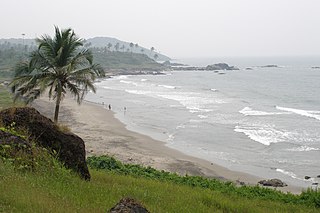
Goa is a state on the southwestern coast of India within the Konkan region, geographically separated from the Deccan highlands by the Western Ghats. It is located between the Indian states of Maharashtra to the north and Karnataka to the east and south, with the Arabian Sea forming its western coast. It is India's smallest state by area and its fourth-smallest by population. Goa has the highest GDP per capita among all Indian states, two and a half times as high as the GDP per capita of the country as a whole. The Eleventh Finance Commission of India named Goa the best-placed state because of its infrastructure, and India's National Commission on Population rated it as having the best quality of life in India. It is the third-highest ranking among Indian states in the human development index.
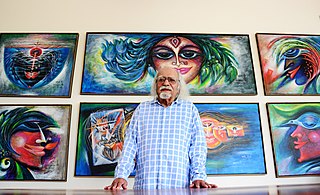
Laxman Pai was an Indian artist and painter. He was a principal of the Goa College of Art, a post he held from 1977 to 1987. Pai was a recipient of several awards including India's third highest civilian honour of Padma Bhushan, awarded by the Government of India.
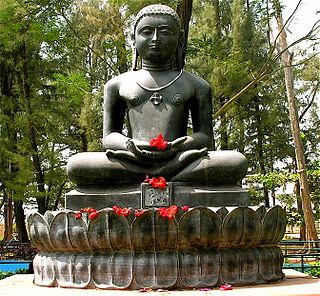
Jainism flourished in Goa during the rule of Kadamba dynasty. Broken sculptures of the Jain Tirthankara Suparshvanatha, belonging to the period of the Goan Kadamba ruler Shivachitta Permadi Dev, were discovered in an old Jain temple in Jainkot, Naroa.
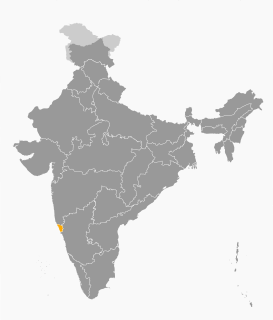
The following outline is provided as an overview of and topical guide to Goa:
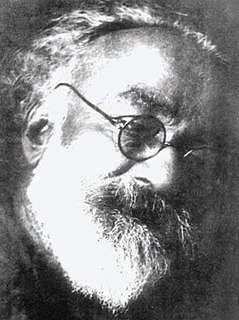
Antonio Xavier Trindade was an important painter of the Bombay School in the early 20th century.

Frederika Menezes is a Goan author, poet and artist. She is best known for her book, Unforgotten. A poem of hers, The Different Normals, is yet to feature in English textbook of the Goa Board of Secondary & Higher Secondary Education (GBSHSE).
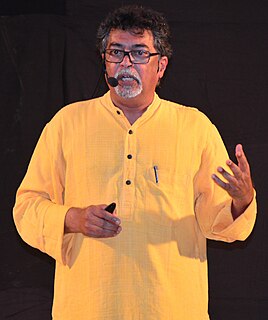
Subodh Kerkar is an Indian painter, sculptor and installation artist, and founder of the private art gallery Museum of Goa. He is known for his artworks and installations.




























